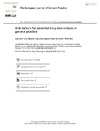Please use this identifier to cite or link to this item:
https://accedacris.ulpgc.es/jspui/handle/10553/48482
| DC Field | Value | Language |
|---|---|---|
| dc.contributor.author | Bjerrum, Lars | en_US |
| dc.contributor.author | González Lopez-Valcarcel, Beatriz | en_US |
| dc.contributor.author | Petersen, Gert | en_US |
| dc.date.accessioned | 2018-11-23T22:12:14Z | - |
| dc.date.available | 2018-11-23T22:12:14Z | - |
| dc.date.issued | 2008 | en_US |
| dc.identifier.issn | 1381-4788 | en_US |
| dc.identifier.uri | https://accedacris.ulpgc.es/handle/10553/48482 | - |
| dc.description.abstract | Objective: To identify patient- and practice-related factors associated with potential drug interactions. Methods: A register analysis study ingeneral practices in the county of Funen, Denmark. Prescription data were retrieved from a population-based prescription database (Odense University Pharmacoepidemiologic Database, OPED) covering prescriptions to all inhabitants in the county of Funen, Denmark. All individuals exposed to concurrent use of two or more drugs (polypharmacy) were identified. Combinations of drugs with potential interactions were registered and classified as major, moderate, or minor, depending on the severity of outcome and the quality of documentation. A two-level random coefficient logistic regression model was used to investigate factors related to potential drug interactions. Results: One-third of the population was exposed to polypharmacy, and 6% were exposed to potential drug interactions during 1 year. Patient factors associated with increased risk of potential drug interactions were high age, a high number of concurrently used drugs, and a high number of prescribers. Practice factors associated with potential drug interactions were a high percentage of elderly patients and a low percentage of female patients listed. Conclusion: Prescription data maybe useful in quality-improvement programmes to identify groups of patients and practices at increased risk of drug interactions. | en_US |
| dc.language | eng | en_US |
| dc.publisher | 1381-4788 | |
| dc.relation.ispartof | European Journal of General Practice | en_US |
| dc.source | European Journal of General Practice[ISSN 1381-4788],v. 14, p. 23-29 | en_US |
| dc.subject.other | Drogas | en_US |
| dc.subject.other | Sistema sanitario español | en_US |
| dc.title | Risk factors for potential drug interactions in general practice | en_US |
| dc.type | info:eu-repo/semantics/Article | en_US |
| dc.type | Article | en_US |
| dc.identifier.doi | 10.1080/13814780701815116 | |
| dc.identifier.scopus | 47149107043 | - |
| dc.contributor.authorscopusid | 7006017468 | - |
| dc.contributor.authorscopusid | 6507677112 | - |
| dc.contributor.authorscopusid | 7202922868 | - |
| dc.description.lastpage | 29 | - |
| dc.description.firstpage | 23 | - |
| dc.relation.volume | 14 | - |
| dc.investigacion | Ciencias Sociales y Jurídicas | en_US |
| dc.type2 | Artículo | en_US |
| dc.utils.revision | Sí | en_US |
| dc.date.coverdate | Julio 2008 | |
| dc.identifier.ulpgc | Sí | es |
| dc.description.scie | SCIE | |
| item.grantfulltext | open | - |
| item.fulltext | Con texto completo | - |
| crisitem.author.dept | GIR Economía de la salud y políticas públicas | - |
| crisitem.author.dept | Departamento de Métodos Cuantitativos en Economía y Gestión | - |
| crisitem.author.orcid | 0000-0002-5571-3257 | - |
| crisitem.author.parentorg | Departamento de Métodos Cuantitativos en Economía y Gestión | - |
| crisitem.author.fullName | González Lopez-Valcarcel, Beatriz | - |
| Appears in Collections: | Artículos | |
SCOPUSTM
Citations
62
checked on Jun 8, 2025
Page view(s)
110
checked on Dec 28, 2024
Download(s)
170
checked on Dec 28, 2024
Google ScholarTM
Check
Altmetric
Share
Export metadata
Items in accedaCRIS are protected by copyright, with all rights reserved, unless otherwise indicated.
